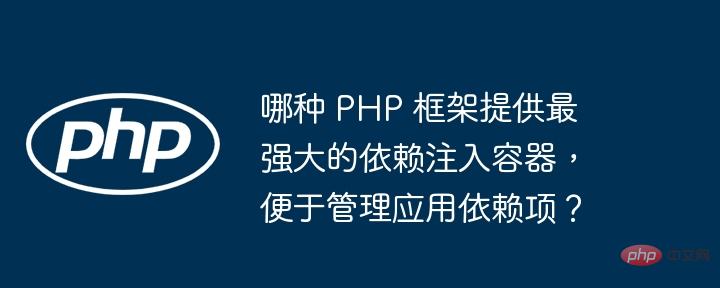Home >Backend Development >PHP Tutorial >Which PHP framework provides the most powerful dependency injection container for managing application dependencies?
Which PHP framework provides the most powerful dependency injection container for managing application dependencies?
- WBOYWBOYWBOYWBOYWBOYWBOYWBOYWBOYWBOYWBOYWBOYWBOYWBOriginal
- 2024-06-01 18:13:01697browse
The Laravel framework has a powerful dependency injection (DI) container, which brings the following advantages: loose coupling, improved testability and reusability, simplified dependency management, easier change and maintenance, better organization, based on type Component Grouping Laravel's DI container (called a "service container") provides powerful features such as automatic binding, type hints, and contracts. By injecting service instances in controllers and binding services in service providers, dependencies can be easily managed, improving code readability and maintainability.

#Laravel: Powering your PHP applications
The dependency injection (DI) container is a core component of the PHP framework that simplifies the management of application dependencies. manage. A strong DI container is crucial when choosing a PHP framework as it improves the maintainability and testability of your code. In this article, we will explore Laravel as a leading PHP framework with an excellent DI container.
Advantages of DI containers
DI containers provide the following advantages:
- Loose coupling:Eliminates hard-coded dependencies between components, Improve testability and reusability.
- Simplified dependency management: Centrally manage all dependencies, simplifying changes and maintenance.
- Better organization: Group components in the container according to dependency types to improve code readability and maintainability.
Laravel's DI container
Laravel's DI container is called a "service container", which provides a series of powerful functions:
- Automatic binding: Dependencies can be automatically resolved without explicit binding.
- Type hints: Supports type hints, providing better code integrity and compile-time error checking.
- Contract: Allows you to create abstract interfaces that facilitate flexible dependency injection.
Practical case
Let us create a simple Laravel controller to demonstrate the DI container:
// app/Http/Controllers/ExampleController.php
namespace App\Http\Controllers;
use App\Services\ExampleService;
class ExampleController extends Controller
{
public function __construct(ExampleService $exampleService)
{
$this->exampleService = $exampleService;
}
public function index()
{
return $this->exampleService->getData();
}
}In this controller, ExampleService## Instances of # are automatically injected through the constructor without manual instantiation.
// app/Providers/AppServiceProvider.php
namespace App\Providers;
use Illuminate\Support\ServiceProvider;
use App\Services\ExampleService;
class AppServiceProvider extends ServiceProvider
{
public function register()
{
$this->app->bind(ExampleService::class, function ($app) {
return new ExampleService();
});
}
}The above code binds the ExampleService interface to its specific implementation class. Now we can easily parse and use the ExampleService class without worrying about its instantiation details.
The above is the detailed content of Which PHP framework provides the most powerful dependency injection container for managing application dependencies?. For more information, please follow other related articles on the PHP Chinese website!

